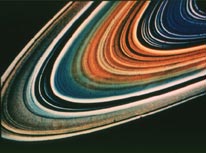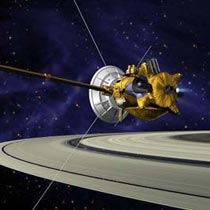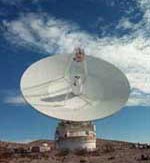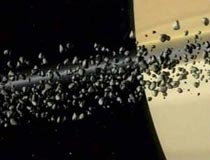| (insert your NIE or newspaper logo here) |
Weekly Online LessonOnline Lesson ArchiveGrade Level: 6-8
|
Solving Saturn's Mysteries
 After nearly seven years "on the road," the spacecraft Cassini finally settled into an orbit around Saturn on Wednesday, June 30, 2004. Hours later, scientists on Earth began receiving brilliant images of Saturn's rings, moons, and other features that will be recorded during the craft's 70-plus passes around the planet over the next four years.
After nearly seven years "on the road," the spacecraft Cassini finally settled into an orbit around Saturn on Wednesday, June 30, 2004. Hours later, scientists on Earth began receiving brilliant images of Saturn's rings, moons, and other features that will be recorded during the craft's 70-plus passes around the planet over the next four years.
The last time experts saw Saturn so closely was about 20 years ago, when Voyager 1 and 2 passed it on their way toward the edge of our solar system.
Scientists don't know a whole lot about Saturn yet, but they do know a few things that distinguish it from other planets in our solar system.
For example, the planet is made mostly of gas and is less dense than water. Hundreds of rings -- made up of ice and rock -- encircle the gaseous body, which move at various speeds. Titan is the largest of more than 30 moons that revolve around the planet, and it's the only moon in the solar system with its own atmosphere.
 Cassini was built to collect a variety of images in different ways and under different conditions. In about six months, the spacecraft's passenger -- the Huygens probe -- will drop onto the surface of Titan and collect additional data and measurements of the moon's physical and chemical properties.
Cassini was built to collect a variety of images in different ways and under different conditions. In about six months, the spacecraft's passenger -- the Huygens probe -- will drop onto the surface of Titan and collect additional data and measurements of the moon's physical and chemical properties.
Of course, simply gathering the data is just one part of the process. Scientists will then need to interpret the information that Cassini and Huygens transmit back to Earth.
So what surprises are in store for scientists over the next four years? What clues may be uncovered to solve some of Saturn's mysteries?
The Messenger
 Before we uncover the answers to what scientists might find there, let's see how they were able to reach their target in the first place.
Before we uncover the answers to what scientists might find there, let's see how they were able to reach their target in the first place.
To do this, launch into a Solar System Experience through NASA's Jet Propulsion Laboratory (JPL) at the California Institute of Technology.
Click Cassini Mission to watch the video animation of the spacecraft's journey. (Make sure to have your audio speakers turned on).
What pathway did Cassini need to take to reach Saturn, and why? Which moons will Cassini visit? Why do you think scientists believe Cassini may discover previously unknown moons?
Return to the Solar System Experience home page and review the Voyager Mission. When were the Voyager crafts launched? What new information about Saturn and other planets did the twin spacecraft provide?
 As you've seen, it takes years for these spacecraft to get to their targets. So why does it take only hours for scientists to receive what their "space eyes" see.
As you've seen, it takes years for these spacecraft to get to their targets. So why does it take only hours for scientists to receive what their "space eyes" see.
To answer that question, let's find out How to Yell Across a Solar System at NASA's Space Place.
Click Continue to learn about The X-band Transponder.
What is the basic form of the data that gets transmitted? What steps must occur to transform the signal into something that makes sense to us?
The Planet
 Now let's find out more about the planet Saturn itself by visiting the official Cassini-Huygens: Mission to Saturn & Titan site.
Now let's find out more about the planet Saturn itself by visiting the official Cassini-Huygens: Mission to Saturn & Titan site.
On the right hand side of the home page, look for the feature titled, Saturn: Journey to a Ringed World. Choose either the Flash or HTML version -- both open in a pop-up window.
In the first section, Saturn, find out why scientists refer to the planet as the Gas Giant, then dig into its Structure: The Inside Story. In what ways does the planet's structure and composition relate to its Magnetosphere? Why Explore Saturn and its satellites? What do scientists hope to learn?
In the next section, discover how Saturn's Rings provide clues into how the solar system formed. Scientists have learned a few things about the planet Through the Telescope & Beyond, like some of its Physical Characteristics. What types of materials are in these rings?
 Also find out what forces experts believe make these Mysterious Rings act the way they do, and Why Explore them. In what ways do you think solving these mysteries could be valuable to science? What about to the people on Earth as a whole?
Also find out what forces experts believe make these Mysterious Rings act the way they do, and Why Explore them. In what ways do you think solving these mysteries could be valuable to science? What about to the people on Earth as a whole?
Now explore the planet's largest moon, Titan. Here, you'll read about Titan's History, and what makes it a Frozen Vault, how it affects the Atmosphere, and Why Explore it. How many years passed after the moon was first spotted did scientists determine it had an atmosphere? What characteristics seem similar to those of early Earth?
Lastly, check out which additional Moons Cassini will flyby during the mission -- from the Shepherd Moons to Mimas, Enceladus, Rhea, Hyperion, and Phoebe. How is each moon different from the others? Do they share any similarities? What do you think caused this variety of materials to collect here?
Newspaper Activities
Look through current issues of Targetnewspaper for any stories about the Cassini-Huygens mission. Did the newspaper include any new images transmitted by Cassini? Have scientists announced any surprises? Does the news reporter explain the significance of the findings? Also look for articles about other space missions. In what ways could those other missions help scientists solve the mysteries of Saturn?
© Copyright 2004
Learners
Online,
Inc.
